Time-Based Art Festival Field Guide: Closing Weekend
Brace yourself for the tidal wave of performance, interactive installations, drag balls, concerts, dance parties, and conversation about some of the least likely topics (see: the sex life of seniors) that is the Portland Institute for Contemporary Art’s Time-Based Art Festival, the weeklong fest that draws artists and audiences from around the world.
Time-Based Art Festival
Sept 11–21
Various Venues &
The Works at Fashion Tech, 2010 SE 8th Ave.
One of the great things about TBA is the snapshot it captures of contemporary art right now. These are some of the most cutting edge artists in the world. Some are making their US debuts (see: Halory Goerger and Antoine Defoort), while others are producing world premiere works. If you have the ability to see multiple shows, you might notice themes emerging. For example, while last year’s fest seemed to focus on the body, with multiple performers incorporating and exploding elements of dance, this year’s lineup delves deeply into the sonic world with a range of artists who are stretching the artistic potential in both the voice and electronic music, which is why we're approaching our reviews with the categories of 'high note,' 'sigh,' and 'low note.'
To help you navigate the dozens of shows, talks, and other activities, we’ve compiled some of our picks into this Field Guide, which we plan to update as the week goes on with digestible mini-reviews. So if you’re stumbling over what to see on a given night, make sure to check back regularly.
Opening Night: THEESatistfaction
Review: "The energy of THEESatisfaction is certainly palpable on record, but the electricity of their live show—as Harris-White and Irons performed waves of synchronized choreography and infectious hooks reverberated through the space—was contagious" at the opening night party, which hit capacity before the show even began. Read our full recap and watch videos from the performance.
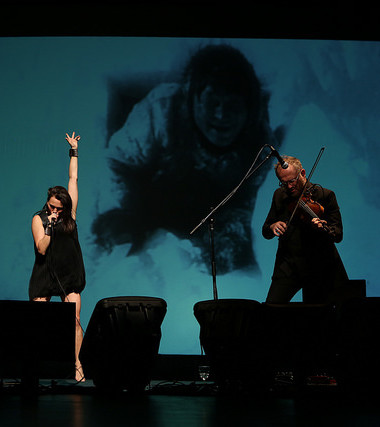
Image: Gordon Wilson
Tanya Tagaq
Fri–Sat, Sept 12–13, at 8:30, PSU Lincoln Hall
Review: Much ink has been spilled about Robert Flaherty’s 1922 film, Nanook of the North. Often billed as the “first documentary film” in history, it tells the story of an Inuk family’s struggles to live in the Canadian Arctic. The film has been “criticized” for many slights of hand and over dramatizations: misportraying things like the hunting tools used at the time (guns had already replaced spears), characters’ relationships (Nanook’s “wives” apparently were actually Flaherty’s common-law wives), and the filming techniques (the “interior” scenes in the igloo were actually done by cutting away the walls for both light and lens depth of field). So, OK, it was really the first docudrama. Still it’s an incredible film.
Tagaq introduced herself with maximum charm and cred, praising Portland as a city and informing that her mom grew up in an igloo then went on to graduate from McGill University. Trained in Inuit throat singing, she and a drummer and violinist inflected the drama, the fun, the artifice, and the simple extraordinariness of Flaherty’s work and power and dignity of the “actors" and their lives (guns or no guns, wives or not).
High Note: Fresh seal meat and blood on the family’s faces, the bared teeth of the jealous alpha sled dog, Tagaq’s lunging mix of screams and guttural growls.
Sigh: Not to equate First People with drumming, but it was hard not to wish for rhythm.
Bottom line: Go. But not on the same night as Samita Sinha. Conceptually the Sinha and Tagaq make sense back to back, sensually they do not. —Randy Gragg
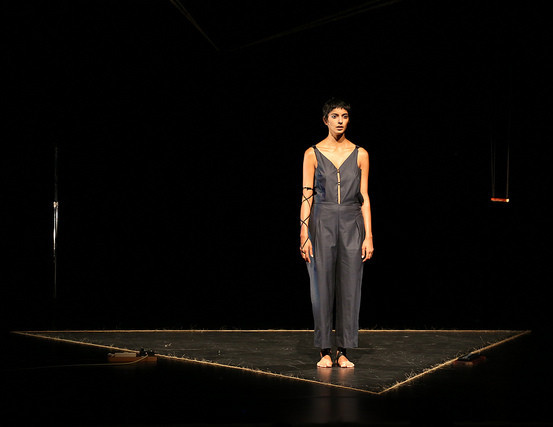
Image: Gordon Wilson
Samita Sinha: Cipher
Fri–Sat, Sept 12–13, at 6:30, Winningstad Theater
Review: As a grad art student at UW in the ‘80s, I hung out with several ethnomusicologists studying Hindustani music. The department brought some of the best classical musicians to be heard, from Lalith Rao to Pandit Ramnarayan. They often played cross-legged atop a table in a lecture hall beneath flickering fluorescent lights, conjuring a sonic narrative that entered your memory through your pores with slowly building ragas and delicate calls and responses between the accompanying musicians. And so I went to hear Samita Sinha’s Cipher with a lot of skepticism: I’ve never enjoyed any of the various Indian fusion musics I’ve heard since. But Cipher stands among the most mesmerizing TBA performances I’ve ever seen. Rather than mash-up, she minimalized, delicately teasing her voice and the elements of the raga form through a vast range of musical territories: the avant garde of Meredith Monk, Joan Le Barbara to the visceral blues of Nina Simone and Betty Lavette.
High Note: Sinha’s accompaniment was a trio of drum machines held aloft on strings playing the simplest of polyrhythms. In one segment, she lies on the floor singing in fades created by a microphone hanging above, metonymically swinging over her. But in a kind of crescendo of economy, through an old-fashioned telephone connected to a bullhorn, she oh-so-delicately conjured the tinny beauty of the muezzin’s prayer call.
Sigh: It’s hard not to wonder whether Sinha is up to the breath and vocal acrobatics of the greatest Hindustani singers. At times she carries a single note into a loop-de-loop that hints “yes.” But sometimes the electronic echo she employs hints of camouflage.
Bottom Line: Go. Listen closely. Breathe with her. Several friends, post-performance, offered the same analogy: I feel like I just had a deep-tissue massage. —RG
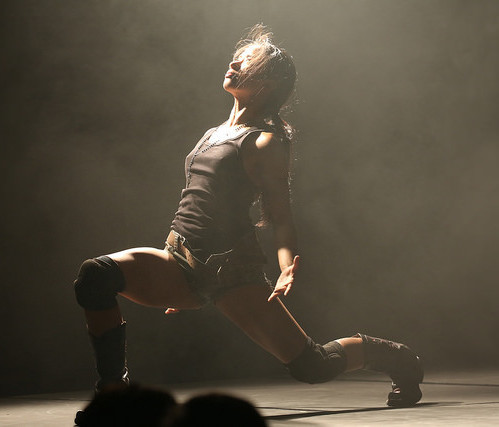
Image: Gordon Wilson
Eisa Jocson: Death of the Pole Dancer/Macho Dancer
Fri–Sat, Sept 12–13, at 8:30, Bodyvox
Review: For those Portlanders who take great pride in the claim that PDX has more strip clubs per capita than any other city and who relish the particular “diversity” of the clubs (vegan, alternative, truckstop, gay, etc.), there is Jocson. A trained ballet dancer from the Philippines, she studied the styles of both female pole dancers and male “macho dancers” (a sinuous, floor-grinding style set to American power ballads particular to the Philippines) to create two vastly different performances that explore all the latent social, political, and gender dynamics enmeshed in the G-strings of exotic dancers.
But don't expect all flash, flesh and sex appeal: both works are as much about the thoughts behind the movement as the movement itself, the dream of the dancer as the dancer her/himself. Death of the Pole Dancer is by far the slower of the two—the labored descent of the stripper who is literally banging herself against the pole before slowly collapsing to a melodramatic cover of the White Stripes' "I Don't Know What to Do with Myself." Macho Dancer, meanwhile, begins more as a straight performance of the form, before cutting the music and turning the bright lights on the audience, creating an uncanny and uncomfortable role reversal.
High Note: Without once feeling like she was parodying the form, Jocson managed to embody the incredible masculine camp of macho dancing: the slow-motion, preening peacock poses drawn from John Wayne movies and Metallica music videos, executed with achingly taut nonchalance (and only one bicep lick). But after the music cuts out, the same moves took on the weight of ritual, and Jocson suddenly felt like a tired warrior who knows he is made cheap by the music and the audience's desire, which was when she walked out and looked into our eyes.
Sigh: It's hard to believe a show about pole dancing could be so slow. I'm hoping it was just the kinks of opening night, but we spent more time waiting in line, waiting in the venue, and waiting at intermission than we did actually watching the performances (the 60 minute show took more than two-hours of the evening).
Bottom Line: If you're looking for the thrill of stripping, try Union Jacks, but if you're the type of person who likes to talk about how most of Portland's exotic dancers are also working on their master's degrees, this is a show for you. —Aaron Scott

Portland drag queen and artist Carla Rossi
Image: Melissa Christy
Critical Mascara: “A Post-Realness Drag Ball"
TBA has a new crown jewel, and, girl, does she glisten and sparkle. Returning for a second year, the Critical Mascara Post-Realness Drag Ball proved she has the staying power to be an over-the-top annual event of outrageous outfits, long legs, glitter, full-body clown makeup, crowd surfing, fake blood, and mad vogue skillz. In other words, a show that will steal the fest every time.
The Works spilled out into the street to accommodate the screaming crowd, some of whom were literally climbing the walls and neighboring trees to get a better view. While the night went long at three hours, the energy held and finally rose up in an ocean of fervor for the final battle where full beers were poured over shining flesh and condoms were pulled from nether regions and thrown at the audience. —AS
Read our full review and watch our slide show and video.
Tahni Holt: Duet Love
Sat–Tues, Sept 13–16, at 6:30, Imago Theatre
Review: Sometimes it doesn’t pay to read the program notes. Portland choreographer Tahni Holt describes her Duet Love as a “work that presents coupled bodies performing gendered states around the romantic premise of the ‘duet’” and that draws inspiration from iconic photos of couples—PICA artistic director Angela Mattox mentioned JFK and Jackie, Kurt and Courtney, Beyonce and Jay-Z—to explore how gender inflects the body.
How that manifested in the actual performance was tenuous at best. The evening started with all four dancers—two men, two women—striking a series of poses, presumably from the photos, that echoed throughout the work. The “markers of gender,” however, seemed limited to said poses and bedazzled ties, trucker caps, and flannel shirts (a rather confounding amalgamation of the three couples). The four dancers occasionally broke into duets, but it felt much more an ensemble piece where costumes, movement, emotion, and gender markers were in a flat, deconstructed state across performers.
If I had not read the notes, I would’ve interpreted the work to be more about the performance of celebrity, with gender but one element, and felt there was maybe something there.
High Note: Watching singer Corrina Repp strut across the stage in black stilettos and transparent cape before singing a single, breathy song about love and casting a long shadow. That was a gendered performance I would have liked to see more thoughtfully integrated and expanded.
Low Note: There were some interesting moments, particularly involving a segment with rolling spotlights performed once in costume and once nude, as well as the skewered levity of the closing, but they cried out for editing.
Bottom Line: If you want to see a dance about gender, I hope you caught Eisa Jocson. If, on the other hand, you’re interested in a dance about pop culture, you might find something here. —AS
Tim Hecker
One-Sentence Review: Body-quaking bass in the pitch dark Lincoln Hall—like if the Cascadian subduction zone were a Disney theme park ride.
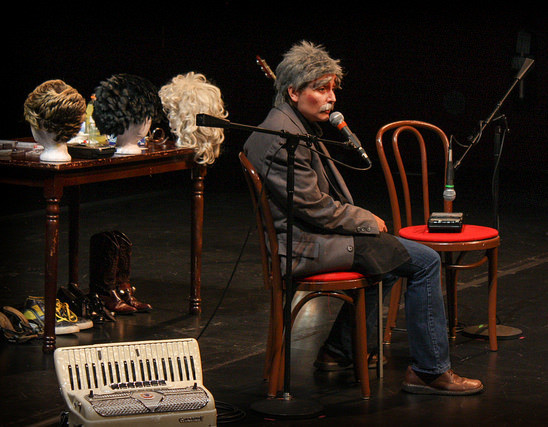
Image: LB Tomczak
Cynthia Hopkins: A Living Documentary
Mon–Tue, Sept 15–16, at 6:30, Winningstad Theater
Review: When she was 24, Hopkins inherited $200,000 from an abusive grandfather. Like any self-disrespecting artist, she resented the money—and the state of having money at all—and decided to burn through it as quickly as possible by starting a theater company and producing a trilogy of visionary over-the-top performances incorporating musical theater, vaudeville, comedy, multimedia, and costumes galore. In the process, she also burned herself out.
But on the bright side, she got story material for this charming, zany, one-woman musical show about the irresistible drive and sometimes overwhelming personal costs of making art—or on an existential scale, finding meaning in life.
With little but a costume rack, make-up table, and a couple of tape decks, Hopkins played six disparate characters/aspects of herself—a cantankerous wizened playwright, a sassy old broad, a sullen twenty-something, a naked folk singer, a self-help guru, and an old British lass—given to breaking into song as they tell her story of hardship and redemption. (“That’s what I like about musicals: Everything is just an excuse for a song,” one says halfway through.)
High Note: Between Hopkins cleverly tongue-in-cheek script and wacky, all-out characterizations (think Lily Tomlin), the audience was in almost a constant state of laughter.
Sigh: Twice the show felt like Hopkins pressed rewind on one of her tape decks, as she jumped back in time to go over the exact same plot point (albeit as different characters). The first jumpback was clever, the second was bafflingly repetitive.
Bottom Line: If you don’t object to another insider artwork about the act of making art, this takes the prize for the most joyful, fun, and accessible performance at the fest yet. —AS
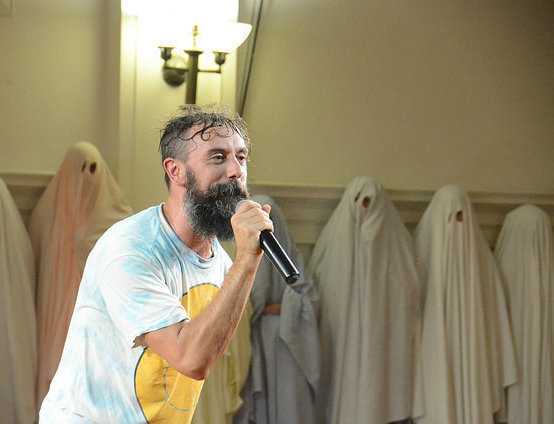
Image: Jonah Levine
Luke George: Not About Face
Sun–Thu, Sept 14–18, at 8:30, Conduit Dance
Review: Not just any artist can make me feel the common denominator between my normally disparate reactions to ISIS and Jeff Koons. But this Melbourne/Brooklyn conceptualist and performer sent the icy chill of fundamentalism and art world megalo-narcisism running down my spine....
Upon entering, a quartet of handlers fits each audience member with sheets, ritualistically. The room full of Caspers, distinguished by nothing more than their heights and the sheets’ pastel pinks and greens and blues, begins the 1.5 hours of George’s mix of ritual and megalomania. Depending on your point of view, it may be this performance’s high point...
As George beckoned—and increasingly ordered—the audience in “Simon-says” cadences, and as those who stayed mostly obeyed (notably, several artists among the assembled left), I began to feel the ISIS/Koons chills. Maybe it was the sheets (funny, but also anonymous, like the executioner in ISIS videos, the tortured in Guantanamo, and the subjugated in fundamentalist societies ). Maybe it was George’s exercise of power and strutting (the self-absorption somehow, for me, conjuring Koons: his “Made in Heaven” series of fuck photos with then wife.) Most likely: a combination of both. I found myself recognizing in fresh ways that the yearning for belief can make people do many things: imagining beheading is justice or that, someday, a stainless-steel Balloon Dog might someday be worth a lot more than $58 million, or that this performance is worth devoting 105 minutes of your life to.
Read the full review.
High Note: The roomful of ghosts: a bunch of strangers, covered in sheets, following orders to spoon.
Low Note: George's long story about imagining a dance performance by another artist—telepathically—right before it happened. Even one seemingly patient member of the audience put it best midway, “We’re with you: What happened next?”
Bottom line: Go if you if you urge to be challenged—and your patience—is high, but smuggle in a bottle of water. Prepare to be obedient. Or, in the spirit of experiment, revolt. —RG

Critics Pick
Mammalian Diving Reflex:
All the Sex I’ve Ever Had
Wed–Sat, Sept 17–20, at 7, PSU Shattuck Hall
Review: After taking this performance's opening pledge that “what happens in All the Sex I’ve Ever Had stays there,” it’s hard to offer many specifics about the confessions made in Shattuck Hall Annex Wednesday night. After all, the pledge ends with “so help us Bud Clark” (Portland's much-loved former mayor who famously stood, raincoat open, in the poster “Expose yourself to art”).
Beautifully coached and produced by the Toronto-centered “research atelier” Mammalian Diving Reflex, three men and two women in their 60s and 70s shared tales of their lives in short snippets through the years. It’s hardly just about sex, but also consequences, randomness, gravity, and, yes, pleasure. It’s also really, really funny. With the easy-going mastery—but less of the packaging—of the storytelling event the Moth, Mammalian teased out the memory, impacts, and the retrospective recognition of moments: whether it was being spanked as a child over walking in on mom in her corset; discovering the joys of masturbating; often-joylessly losing one's virginity (and the total joy of the first orgasm); getting married after a good roll in the hay; staying in a relationship out of threats; of getting herpes in your 60s.
High Note: Mammalian nicely involves the audience with quick polls of hands of “Who has done . . . ?” and then drilling down with one person, the emcees unabashedly asking for details. Given the candor on stage, you can offer no less.
Low Note: There really aren’t any—and I, personally, am routinely bored by confessional performance. The variety of five people recalling brief moments over six decades can’t help but trip the wires of all the turns and twists in your own life. Sex is, in reality, like walking: you lean forward and you catch yourself or you fall . . . and get back up to lean forward again.
Bottom line: Go. Epic but easy going, All the Sex I Ever Had is, in the end, a record of five love lives lived well (one of them even evading almost certain death four times over)—and a reminder it's best to do the same. Even I—normally relishing the theater’s fourth wall—shared an experience from my sex life. But keeping my pledge to Bud Clark, it’s gonna stay in Shattuck Hall. —RG
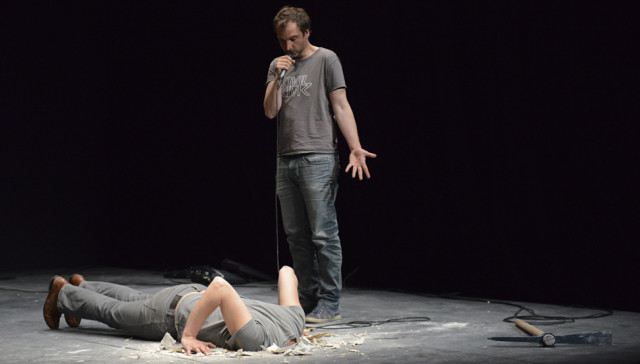
Critics Pick
Halory Goerger and Antoine Defoort: Germinal
Thu–Fri, Sept 18–19, at 8:30, PSU Lincoln Hall
Review: Germinal is one of the most creative and wondrous pieces of theater I’ve ever seen. The premise is strangely and deceptively simple: four people on a dark stage inventing existence from scratch. Of course, creation begins with light, as the four slowly master their light boards. But then they have to invent sound, language, emotion, and physics while trying to figure out how to categorize everything.
The absurdist comedy arrives in the contradiction between what the four individuals already know and what they have to discover, between the technology that preexists in their universe (microphones, electric guitars) and the basic physical and mechanical laws they have to invent. For example, in trying to figure out how to physically speak (they’re already communicating telepathically), they coach each other with linguistically versed phrases like “close your glottis” and “build phonemes.” The result is an incredible philosophical underpinning to the humor and poignancy without the show ever feeling pretentious.
High Note: It’s hard to say much without giving away the discoveries of the show, but suffice it to say there’s singing, a conversation with a universal operator (that is, an operator who can install things into their confined universe like the law of thermodynamics), the destruction of the stage with a pick axe, and the most amazing use of Windows you’ve ever seen.
Bottom Line: At heart, the show is an exceptionally inventive exploration of creativity, curiosity, and joy—all the things that make living in this universe worthwhile. This is the can’t miss show of the festival—and possibly the year. Beat someone up and steal their ticket.
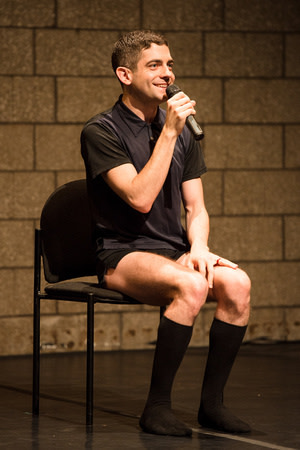
Jack Ferver
Thurs–Fri at 6:30 and Sat at noon, Sept 18–20, Ecotrust
Review: Jack Ferver likes to talk about himself. At least, that’s his schtick for Mon, Ma, Mes. Taking his seat in the Ecotrust conference room, the New York–based artist began by explaining that we’d be doing the Q&A segment of the performance first, before starting to point out audience members for raising their hands (none, of course, had) and then having an assistant pass them a card with a question to read. All were ego-fluffing softballs worthy of Barbara Walters, such as “How have you accomplished so much at such a young age?” and “Do you want to have children?”
High Note: The humor is in the hubris. Ferver pulled off the artist’s neurotic self-absorption with considerable comedy and charisma.
Sigh: Ferver interspersed earnestly over-the-top dance sequences with the answers. The first was funny, but then they started to wear. The work also took a turn for the heavy towards the end as Ferver transitioned a joke about getting raped into a melodramatic confession of how art had saved his in light in response to said rape and suicidal thoughts. It’s somewhat unclear whether he was still performing the persona of the artist or wanted us to take him seriously, which theoretically is a success, given his stated goal in the program to blur the boundaries “between the realms of grand theatrics and stark naturalism, the persona and the self.” But whether it gave the show enough weight to elevate it from a cute comedy schtick to something more was even more ambiguous.
Bottom Line: The show is a quick romp that works best as a palette cleanser, pricking the heady bubble of some performance art.
Jennifer West: Flashlight Filmstrip Projections
Sept 11–30, The Works at Fashion Tech
As movie studios shift almost exclusively to digital cameras and celluloid film goes the way of Polaroids, this LA artist's work hangs on, refusing to let go of the very physical nature of film. In the past, she's smeared celluloid film with M&M's and mezcal worms and then projected it, and in this new commission, she hangs a series of filmstrips in a dark room and then equips the viewers with flashlights to project their own films on the wall. The description might be heady (West calls it the first of her "pre-post fragmented cinematic environments"), but the experience looks like it could be sheer pleasure.




